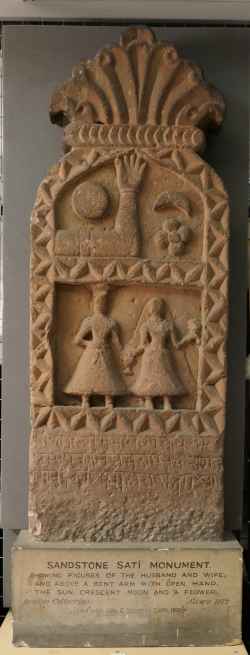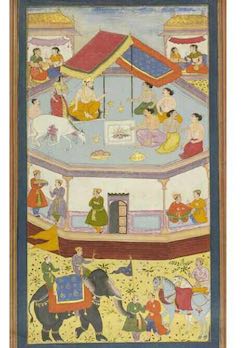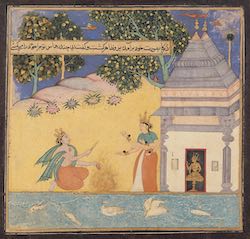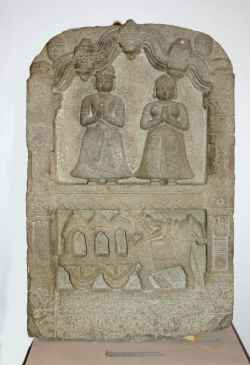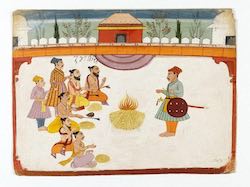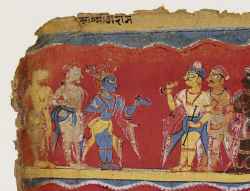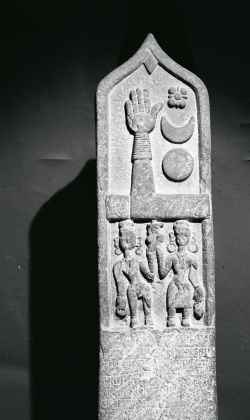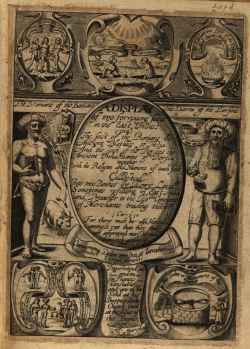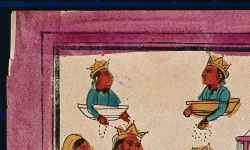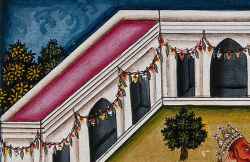Keyword: India – Image Gallery
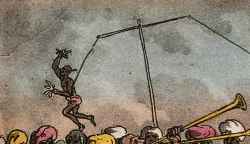
Suttee, with Lord Hastings shown as accepting bribes to allow its continuation (1815)
London, Wellcome Collection

Valmiki instructs Kusha and Lava in the recitation of the "Ramayana" before the occasion of a sacrifice in Rama's palace (1597-1605)
from: The Ramayana (Tales of Rama; The Freer Ramayana), Volume 2
National Museum of Asian Art, Smithsonian Institution, Washington D.

The Funeral Pile of a Husband (1810)
http://www.columbia.edu/itc/mealac/pritchett/00routesdata/1800_1899/hinduism/sati/sati.html
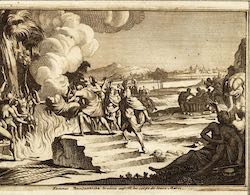
Femmes Benjanoises brulees (1725)
from: van der Aa, P. La galerie agreable du monde. Tome premier des Indes Orientales, Leiden, c. 1725
http://www.columbia.edu/itc/mealac/pritchett/00routesdata/1800_1899/hinduism/sati/sati.html

Manner in which the Women in India Burn (1728)
from: Picart, B. Ceremonies et Coutumes Religieuses des Peuples Idolatres, tome II, Amsterdam, 1728
London, Wellcome Collection

Woman Committing Sati (17th century)
Harvard Art Museum, Boston (https://harvardartmuseums.org/art/165399)

Historica Relatio1 (1598)
from: Peruschi, G. Historica Relatio, de Potentissimi Regis Mogor, Mainz, Breem, 1598
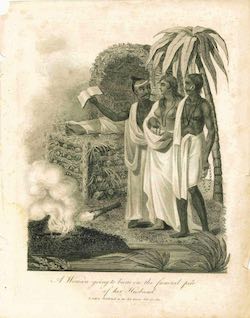
Woman Going to Burn (1811)
http://www.columbia.edu/itc/mealac/pritchett/00routesdata/1800_1899/hinduism/sati/sati.html

Deities and Demons Performing the Yajna Sacrifice from the Devi Mahatmya (18th)
from: India, Rajput
Princeton University Art Museum

A Gentoo Woman Burning Herself (1770)
http://www.columbia.edu/itc/mealac/pritchett/00routesdata/1800_1899/hinduism/sati/sati.html
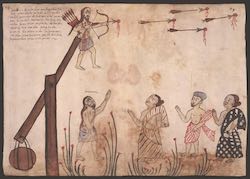
Indian Sacrifice with Harrows (16th Century)
Biblioteca Casanatense, ms. 1889, c. 88r, Rome
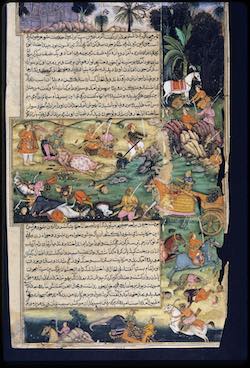
Satrughna is wounded by Kusa and Lava during Rama's horse-sacrifice (1616)
from: Leaf from a dispersed manuscript of Razmnama
Harvard University, Fine Arts Library, SS_22349926
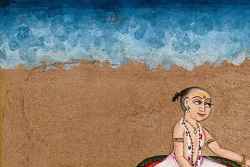
Four priests perform a yagna, a fire sacrifice to Agni [1800-1900]
London, Wellcome Collection
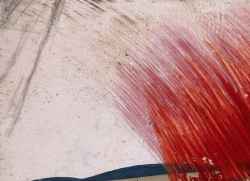
Sati (suttee): a woman immolating herself on her husband's funeral pyre. Gouache painting on mica by an Indian artist. (1800-1899)
from: India
London, Wellcome Collection

Bramenes cum mortuus est (1598)
from: Banerjee, P. Burning Women, New York, Palgrave-Macmillan, 2003, p. 92

Immolation of a Hindoo Widow (1814)
from: Lester. The Gallery of Nature and Art, 1814
London, Wellcome Collection
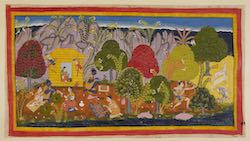
Prior to taking up their abode in the hut, oblations have to be made to the presiding deities. Lakṣmaṇa hunts deer on the right, and returns to the hut to cook it; Rāma offers part of it as a sacrifice. The two brothers then eat, while Sītā waves a scarf over the food to keep the flies off, and she then retires to the hut to eat her own meal. The three begin their lives in exile in the peace of Citrakūṭa (ca 1653)
from: Ramayana, [ms Add. 15296(1), fol. 71]
British Library, London [from Udaipur]

A Gentoo Woman Burning herself (1768)
from: Cavendish Drake, E. A, Universal Collection of Authentic and Entertaining Voyages and Travels, London, J. Cooke, 1768

Burning of a Hindu Widow at Her Husband’s Funeral Pyre (1666?)
from: Banerjee, P. Burning Women, New York, Palgrave-Macmillan, 2003, p. 87
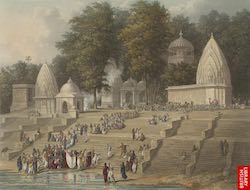
Preparation for a Suttee (1816)
British Library, London (http://www.columbia.edu/itc/mealac/pritchett/00routesdata/1800_1899/hinduism/sati/sati.html)
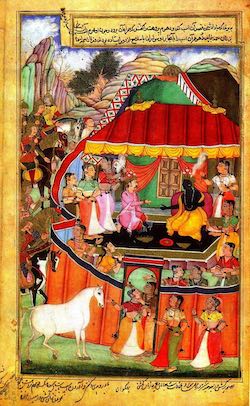
Ladies of Krishna's Harem are Shown the Sacrificial Horse (1598)
from: Razmnama Mughal
Oriental and India Office Collection, British Library, London

A Suttee (1858)
http://www.columbia.edu/itc/mealac/pritchett/00routesdata/1800_1899/hinduism/sati/sati.html
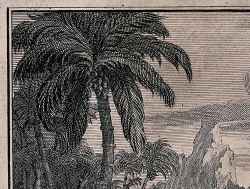
Manner in which they Bury Themselves (1728)
from: Picart, B. Ceremonies et Coutumes Religieuses des Peuples Idolatres, tome II, Amsterdam, 1728
London, Wellcome Collection

The building for King Dasaratha's sacrifice (Mughal India) (1594)
from: Miniature (35.4 x 21cm), fol. 27r
Christie's, London

Woman Throwing Herself in the Pyre (1699)
from: Banerjee, P. Burning Women, New York, Palgrave-Macmillan, 2003, p. 94
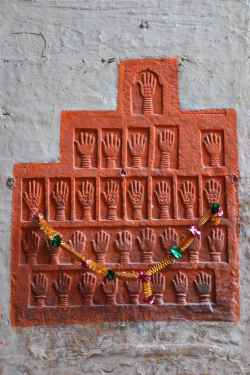
Handprints left by the wives of the maharaja before the Sati [1843]
Mehrangarh Fort, Rajasthan, India
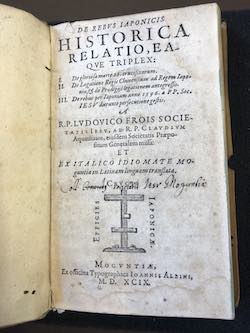
Historica Relatio2 (1598)
from: Peruschi, G. Historica Relatio, de Potentissimi Regis Mogor, Mainz, Breem, 1598
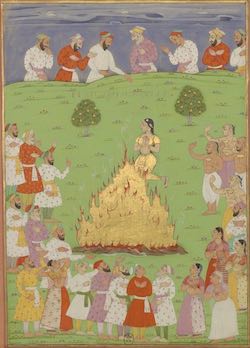
A scene of Sati ritual Souryabha. Femme duchadja Jasingha se brulant. On represente icy la maniere en laquelle se brusla une femme de Radja Jasing appellée en la langue Indienne - Souryabha, qui veut dire lumiere du soleil, elle se brusla sans faire paroistre acucune crainte du feu ni de la mort. (1678-1686)
from: Nicolo Manucci, Histoire de l'Inde depuis Tamerlank jusquà Orangzeb [ms Libro Rosso, fol. 50v]
Bibliothèque nationale de France, Paris
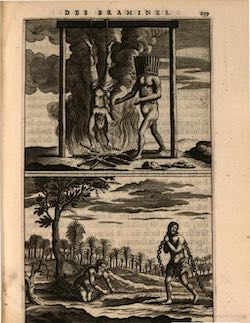
Brahmin undergoing the test of fire after prolonged penance and yoga practices; Yogi dragging heavy iron chains; and a man tied to a tree who has chosen to embrace death (1670)
from: Abraham Rogerius, Le Théâtre de l’idolatrie ou la porte ouverte, Amsterdam, Jean Schipper, 1670, p. 252
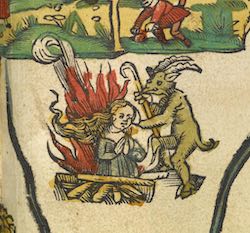
Depiction of a satī on a map. A horned figure standing by a woman burning on a pyre (1522)
from: Claudii Ptolemaei... [Maps.C.1.d.11]
British Library, London

Rishyasringa performing the ceremony for obtaining sons. He is shown chanting mantras and pouring obligations into a fire with the help of priests (1712)
from: Ramayana, Bala Kanda [Udaipur]
London, British Library, Add. 15295, f. 36
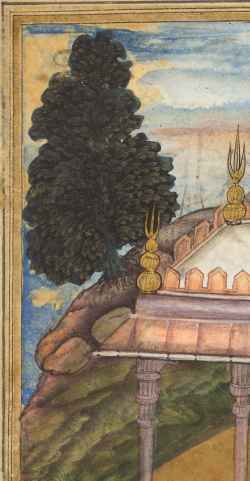
Yaja and Upayaja perform a sacrifice for the emergence of Dhrishtadyumna from the fire (1598)
from: from Adi-parva (volume one) of the Razm-nama (Book of Wars) adapted and translated into Persian by Mir Ghiyath al-Din Ali Qazvini, known as Naqib Khan (Persian, d. 1614) from the Sanskrit Mahabharata
The Cleveland Museum of Art
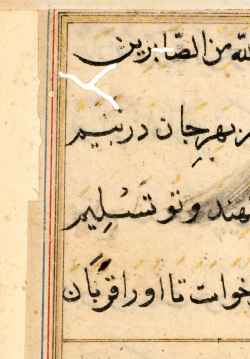
The sentinel in the employ of the Shah of Tabaristan prepares to sacrifice his son to the ghost of the Shah’s soul (Mughal India, court of Akbar) (1560)
from: from a Tuti-nama (Tales of a Parrot): Second Night
The Cleveland Museum of Art
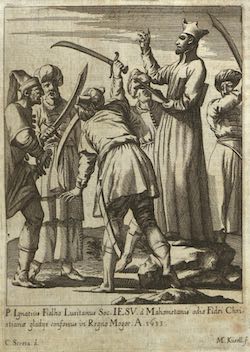
Ignatius Fialho, missionary in the Maghul empire, surrounded by Muslims woth swords (1675)
from: Tanner, Mathias, Societas Iesu usque ad sanguinis et vitae profusionem militans, Typis Universitatis Carolo-Ferdinandeae in Collegio Societatis Jesu ad S. Clementem, Prague 1675, p. 342

Hanuman and the monkeys assault the demons, forcing Indrajita to break off the sacrifice that would make him invincible (1597-1605)
from: The Ramayana (Tales of Rama; The Freer Ramayana), Volume 2
National Museum of Asian Art, Smithsonian Institution, Washington D.C.

Les veuves du Cormandel (1725)
from: van der Aa, P. La galerie agreable du monde. Tome premier des Indes Orientales, Leiden, c. 1725
http://www.columbia.edu/itc/mealac/pritchett/00routesdata/1800_1899/hinduism/sati/sati.html
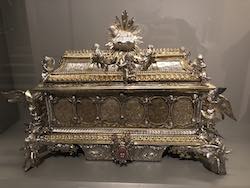
Reliquary of Joao de Brito (1694-98)
Museu de São Roque, Lisbon
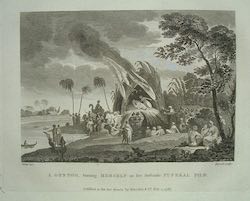
A Gentoo Burning Herself (1783)
from: The Geographical Magazine, London, Harrison & Co., 1783
http://www.columbia.edu/itc/mealac/pritchett/00routesdata/1800_1899/hinduism/sati/sati.html

An illustration from the Ramayana. Rāma and Lakṣmaṇa protect the rishis' sacrificial fire from the rakṣasas (demons) (1800-1805)
from: This is from a series of eighty-four paintings on European paper and was once stored in a folder labelled: 'Ramayana Subjects, Deccani School: 1800-1805 (on European paper)'.
British Museum, London

A mountain city with multistoried hill architecture. Outside the gates on the right is a Saivite shrine with a lingum covered by floral offerings to which a goat is led, probably for sacrifice. (17th)
from: Unidentified Hindu chronicle of a King
Metropolitan Museum, New York
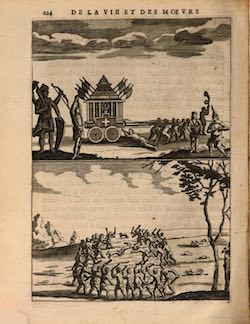
Ritual killing of a goat and a fox during ceremonies in honor of Vishnu and Shiva (1670)
from: Abraham Rogerius, Le Théâtre de l’idolatrie ou la porte ouverte, Amsterdam, Jean Schipper, 1670, p. 224

Snake Sacrifice [1690]
from: Udaipur, Rajasthan state, Mewar, India
Henri Vever Collection, Freer|Sackler gallery at the Smithsonian Institution
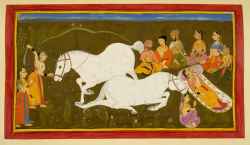
Horse sacrifice (Asvamedha) (1712)
from: Ramayana, Bala Kanda, Ms Add. 15295, fol. 33
British Library, London [from Udaipur]
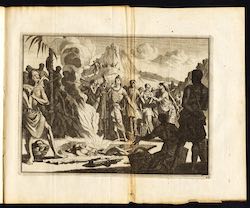
Naauw-keurige aanteekeningen van William Methold (1707)
from: van der Aa, P. Naauw-keurige aanteekeningen van William Methold, Presiden van de Engelsse Maatschappy, gehouden op sijn Voyagie, in het jaar 1619, Leiden, 1619
http://www.columbia.edu/itc/mealac/pritchett/00routesdata/1800_1899/hinduism/sati/sati.html

Suttee (1878)
from: Murray Smith, D. Round the World: A Story of Travel Compiled from the Narrative of Ida Pfeiffer, London, 1878
http://www.columbia.edu/itc/mealac/pritchett/00routesdata/1800_1899/hinduism/sati/sati.html
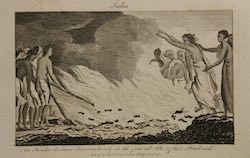
Hindoo Woman throwing herself (19th century?)
http://www.columbia.edu/itc/mealac/pritchett/00routesdata/1800_1899/hinduism/sati/sati.html
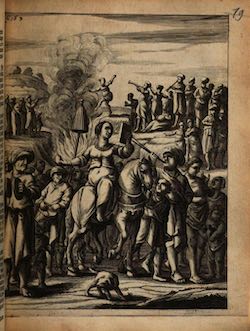
Scene of a sati. In the foreground, a widowed woman (encountered by Della Valle on November 12, 1623) on horseback holds a mirror and a lemon amidst a crowd. In the background, a woman throws herself into the flames of a funeral pyre (1665)
from: Della Valle, Pietro, De volkome beschryving der voortreffelijke reizen van de deurluchtige reisiger Pietro della Valle, edelman van Romen, in veel voorname gewesten des werrelts, sedert het jaer 1615, tot in 't jaar 1626 gedaan. Amsterdam, Abraham Wolfgang, 1666, vol. 5, pag. 163

Les femmes Indiennes se brulent (1725)
from: van der Aa, P. La galerie agreable du monde. Tome premier des Indes Orientales, Leiden, c. 1725
http://www.columbia.edu/itc/mealac/pritchett/00routesdata/1800_1899/hinduism/sati/sati.html
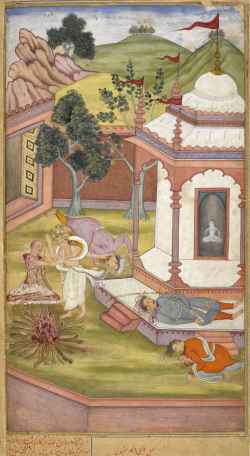
Candrahasa sacrifices himself cutting off pieces of his own flesh and putting them on the fire [1598]
from: Razmnāmah by Abhinanda, India (The last volume of the Persian translation of the Mahābhārata commissioned in 990 by Akbar)
London, British Library, Or 12076 folio: 90v
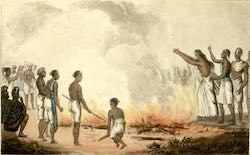
Hindoo Widow Burning Herself with the Corpse of the Husband (1820)
from: Shoberl, F. The World in Miniature: Hindoostan, London, Ackerman, 1820s
http://www.columbia.edu/itc/mealac/pritchett/00routesdata/1800_1899/hinduism/sati/sati.html
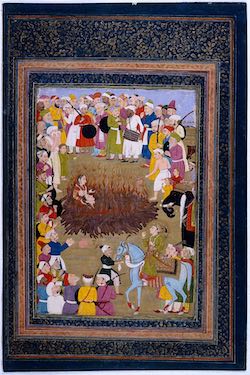
Hindu Princess Committing Suttee (17th century)
Wellcome Library, London
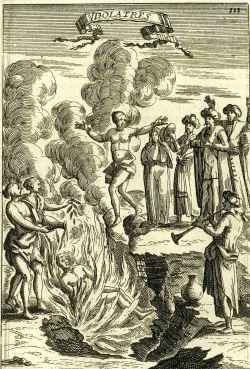
Idolatres (1685)
from: Allain Manesson Mallet, Description de l'Univers, , contenant les differents systêmes du monde, les cartes générals et particulières de la géographie ancienne et modern. Vol.: De l'Asie.
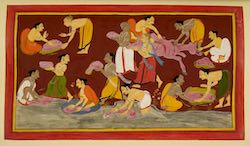
The sacrificed horse is prepared (1712)
from: Ramayana, Bala Kanda, Ms Add. 15295, fol. 34
British Library, London [from Udaipur]
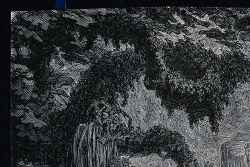
Human sacrifice among the Khonds in India: a victim (meriah) about to be dismembered (1860)
London, Wellcome Collection
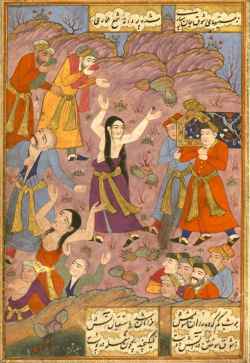
the young Hindu woman accompanies her bridegroom's coffin to the funeral pyre and decides to commit sati (1657)
from: Walters manuscript W.649 (Burning and Melting)
The Walters Art Museum
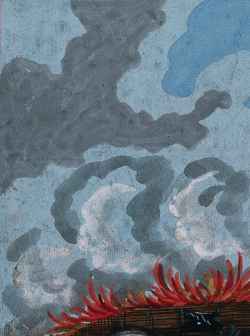
Suttee. Gouache painting by a painter of Thanjavur (Tanjore) [1800]
from: Tanjore
London, Wellcome Collection
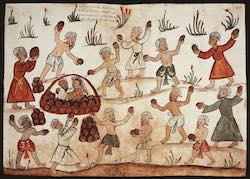
Satī. Gentile women of the caste of the cattle drivers, who is buried alive with her husband after he had died [1540]
Codice Casanatense, Biblioteca Casanatense, ms. 1889, fol. 64r, Rome
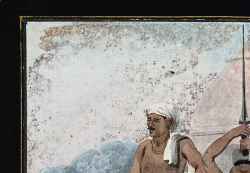
A goat about to be beheaded as a Hindu ritual in honour of the goddess Kālī (1800-1899)
Wellcome Collection, London

The divine messenger (Agnipurusha) rises from the sacrificial fire to bear vessel of celestial food by Nadim (1597- 1605)
from: The Ramayana
National Museum of Asian Art, Smithsonian Institution, Washington D.C.

Suttee Pillar at a Benares Burning Ghat (19th century)
http://www.columbia.edu/itc/mealac/pritchett/00routesdata/1800_1899/hinduism/sati/sati.html
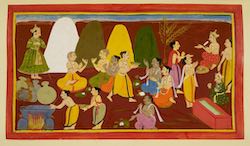
The feast before the sacrifice (1712)
from: Ramayana, Bala Kanda, Ms Add. 15295, fol. 31
British Library, London [from Udaipur]

Handprints of women who committed sati
Wall of the Junagarh Fort (Bikaner, Rajasthan, India)
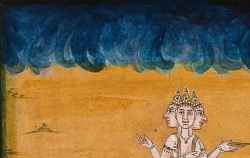
Vishnu, Brahman and three other deities perform a yagna, a fire sacrifice (1800-1899)
London, Wellcome Collection
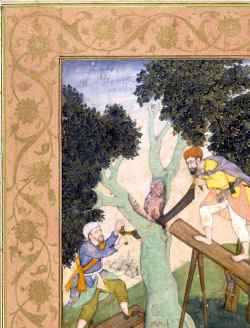
The martyrdom of the prophet Zakariya, who, taking refuge in a tree, was sawn in half by two men. (1605 - 1610)
from: This album of 104 folios known as the Clive Album
London, V&A Museum
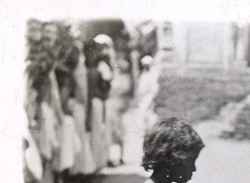
Two boys preparing to sacrifice a young buffalo, Vārānasi , India (1920)
Yale University Library

Sati Funeral Practice (1611)
from: Johannes Isacius Pontanus, "Rerum et urbis Amstelodamensium historia", Amsterdam, 1611, p. 189
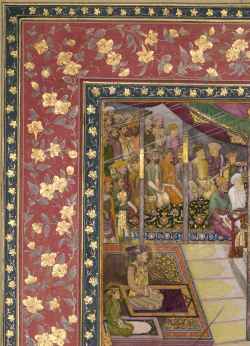
Emperor Jahangir and Prince Khurram at the gathering for the Feast of the Sacrifice (1615-1625)
from: India
Staatliche Museen zu Berlin, Museum für Islamische Kunst

Musei Borgiani Velitris. Tab III pictura indica autographa exhibens sacrificium Túkam (1791)
from: Paulinus a S. Bartholomaeo, Systema Brahmanicum liturgicum, mythologicum, civile, Rome 1791
New York Public Library
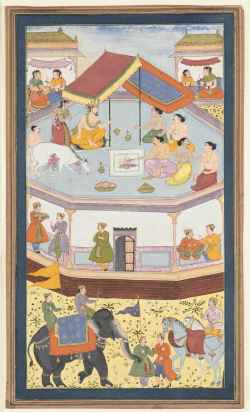
The sacrifice of the horse (asvamedha) by King Yudhisthira [1598 - 1605]
from: Ramznama
Louvre, Paris
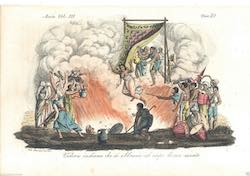
Vedova indiana che si abbrucia (1816)
from: Ferrario, G. Il costumo antico e moderno, Florence, c.1816
http://www.columbia.edu/itc/mealac/pritchett/00routesdata/1800_1899/hinduism/sati/sati.html
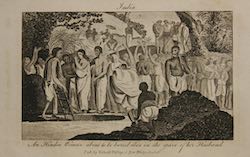
Hindoo Woman about to be Buried (1811)
from: Goldsmith, J. Geography on a Popular Plan, London, Richard Phillips, 1811
http://www.columbia.edu/itc/mealac/pritchett/00routesdata/1800_1899/hinduism/sati/sati.html

A Ruler Performing Yajna (Fire Ritual) (1801 - 1900)
Islamic & Indian Paintings, The Dexter Collection Part II, London
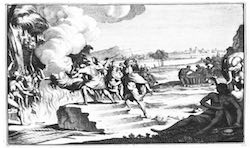
Woman Thown into the Pyre (1563)
from: Banerjee, P. Burning Women, New York, Palgrave-Macmillan, 2003, p. 99
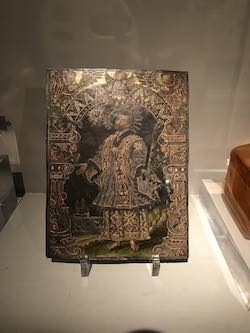
Francis Xavier (17. sec)
Museu de São Roque, Lisbon

Reliquary Casket (16. sec)
Museu de São Roque, Lisbon
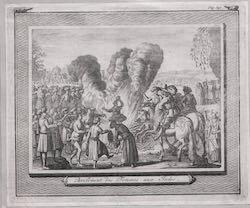
Brulement des femmes (1700)
http://www.columbia.edu/itc/mealac/pritchett/00routesdata/1800_1899/hinduism/sati/sati.html
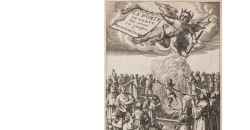
Scene of a Sati, with a woman throwing herself into the flames amid a crowd playing trumpets. Above, a winged devil holds the banner with the book's title and the torch with which he lights the ritual fire. (1670)
from: Abraham Rogerius, Le Théâtre de l’idolatrie ou la porte ouverte, Amsterdam, Jean Schipper, 1670, title page
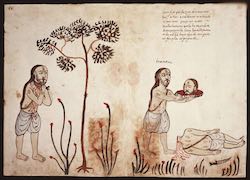
Indian Sacrifice by Behaeding (16th Century)
Biblioteca Casanatense, ms. 1889, c. 86r, Rome
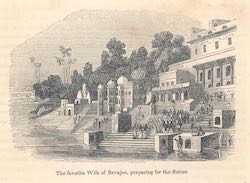
Favorite Wife of Sevajee (1851)
http://www.columbia.edu/itc/mealac/pritchett/00routesdata/1800_1899/hinduism/sati/sati.html

Veuve hindoue allant au bucher (1797)
from: Abdul-Kerym, Voyage de l'Inde a la Mekke, ca. 1797
http://www.columbia.edu/itc/mealac/pritchett/00routesdata/1800_1899/hinduism/sati/sati.html

In the palace, Rāvaṇa and his remaining brothers and sons are bowed down by grief and Rāvaṇa wonders how he can ever be victorious in this conflict, when so many demon champions have been slain. Another son, Indrajit, boasts that he will overcome Rāma and Lakṣmaṇa and sets out in his chariot, surrounded by other demons on elephants, horses and in chariots. In a separate chamber (the text actually says on the battlefield), he prepares offerings, seizing a young black goat by the neck, to the god of Fire in order to conjure up his most magical weapons and to make himself invisible. (ca 1653)
from: Ramayana [ms Add. 15297(1), fol. 97]
British Library, London [from Udaipur]

